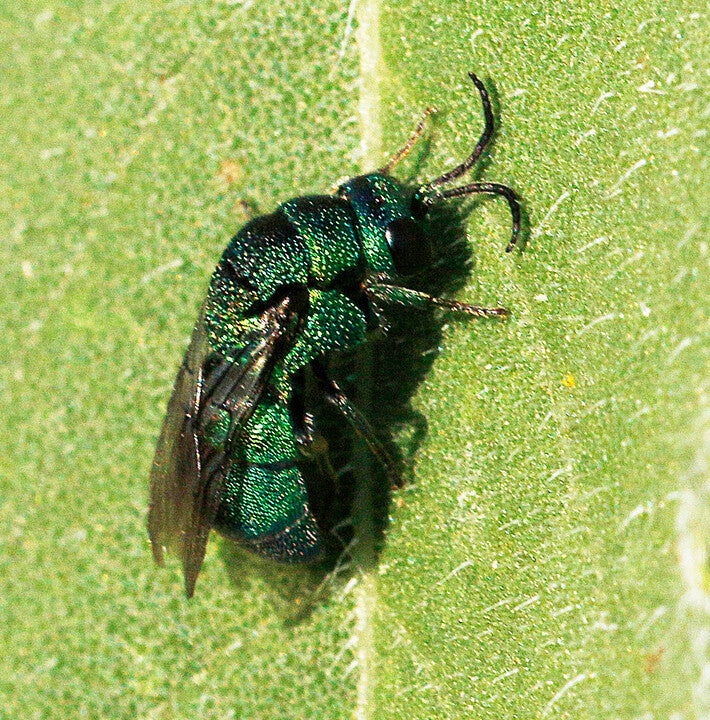My favorite sandwich is peanut butter with Colorado honey. The first insect most kids learn about is the honey bee which is actually the introduced species, Eurasian Honey Bee (Apis mellifera). Mellifera is Latin for honey-bearing. Eurasian Honey Bees were imported by settlers to the U.S. in the 1600’s. This species is now found all over the world except for in the high arctic, Antarctica, and the Sahara Desert. Honey bees are different from the many native Chico bee species in that honey bees form a colony with a queen and workers all living in a hive and producing honey.


Colorado native bees mostly nest solo in a ground burrow. Native bees are exciting to watch and interesting to learn about. For example, the Alfalfa Leaf-Cutter Bee was accidentally introduced into the U.S. from Canada just prior to 1940 and is now considered to be the most important commercial bee to aid in the pollination of alfalfa. When honey bees are introduced into alfalfa fields the seed production increases five-fold. However, when Alfalfa Leaf-Cutter Bees (Megachile rotundata) are introduced into alfalfa fields, the seed production increases fifteen-fold. Alfalfa Leaf-Cutter Bees are now responsible for two-thirds of the world’s alfalfa production.

After the European honey bee, the next most recognizable group of bees is likely bumble bees in the genus, Bombus, from the Greek word bombos which means “a buzzing sound”. There are 46 species of bumble bee in the U.S. and 24 species have been identified in Colorado. One of the more common bumble bee species on the plains in summer is Brown-Belted Bumble Bee (Bombus griseocollis).

In years of average rainfall on Chico Basin Ranch we find high numbers of sunflowers and coneflowers along the roads and on the plains and sand hills. Coneflowers attract a number of bee species including the large bee, Svastra obliqua.

A close look at this photo shows a large amount of pollen attached to this female’s hind leg. Svastra female bees have very long, special, pollen-collecting hairs. Male bees do not have leg hairs and therefore only accidentally gather pollen. A small bee, this female Mining Bee (Perdita albipennis), also shows accumulated pollen collected on her specialized hind leg structures called “scopa”.

Some native bees are pollen thieves. This cleptoparasitic cuckoo bee, Triepeolus sp. for instance. None of the cuckoo bees have pollen collecting hairs and since they steal pollen from other bee species they don’t need them. Female cuckoo bees enter other bee species’ burrows and she lays an egg on one of the hosts nest cells. Triepeolus (like this one pictured below) and other bee and wasp species can sometimes be found sleeping in the early morning where they use their mandibles to attach to a flower or to part of the plant’s stem. Bees that steal pollen often don’t have their own nests. A visit to Chico flowers in the morning or late afternoon can usually reveal several species of sleeping bees and sleeping wasps.

Some common Chico bees appear to be colonial since hundreds of tunneled entrances can be seen a few feet apart in June and July, but in fact the term to describe these digger bee associations is an “aggregation”.

A perfect senior high school or college biology project would be to watch and describe insect visitors coming to the digger bee aggregations where I have observed interesting interactions between digger bees and potential nest predators. One of the common digger bee predators are velvet ants which are actually wasps in which wingless females can be seen walking on the ground like ants. Although female velvet ants walk, the less common males have wings and can fly.

Some bees are attracted to human sweat and not surprisingly they are called “sweat bees”. Most Sweat Bees are brilliantly metallic but difficult to separate even to genus. For example, the three genera, Augochlora, Augochlorella, and Augochloropis, all have metallic green thoraxes and often the green extends to the abdomen which often has contrasting stripes.

After a lot of practice you will eventually be able to separate them to genus. Also, watch for small, chunky, metallic green wasps called “cuckoo wasps” which can look very similar to green sweat bees. How does one tell this is a cuckoo wasp and not a bee? Wasps do not intentionally collect pollen so on examination of the hind legs and underneath the abdomen there are no specialized pollen collecting hairs and therefore this is a wasp in the general category, cuckoo wasp.

Finally, there are some interesting bees found only in the trumpet-shaped flowers of members of the cucumber plant family. These bees are fairly easy to spot in the morning where they are found collecting pollen and nectar from inside a common roadside Chico plant, the buffalo gourd.
Here is an example of a Xenoglossa bee inside the buffalo gourd (Cucurbita foetidissima).

Adding to the exciting hunt to find Chico bees during the summer of 2020 I discovered two bee species on Chico Basin Ranch never before recorded in Colorado, but that is another story.


Leave a comment